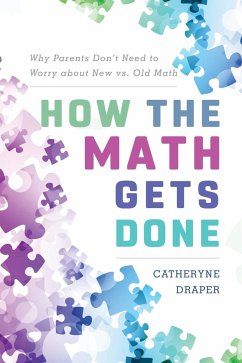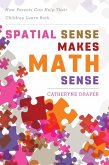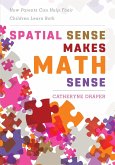- Gebundenes Buch
- Merkliste
- Auf die Merkliste
- Bewerten Bewerten
- Teilen
- Produkt teilen
- Produkterinnerung
- Produkterinnerung
How the Math Gets Done: Why Parents Don't Need to Worry About New vs. Old Math provides a roadmap to understanding what the symbols for math operations (add, subtract, multiply, and divide) really mean, what the clues are to interpret these symbols, and a kind of short story of how they evolved over time.
Andere Kunden interessierten sich auch für
![Kids are Smart Enough, So What's the Problem? Kids are Smart Enough, So What's the Problem?]() Richard W. GarrettKids are Smart Enough, So What's the Problem?42,99 €
Richard W. GarrettKids are Smart Enough, So What's the Problem?42,99 €![Spatial Sense Makes Math Sense Spatial Sense Makes Math Sense]() Catheryne DraperSpatial Sense Makes Math Sense89,99 €
Catheryne DraperSpatial Sense Makes Math Sense89,99 €![User-Friendly Math for Parents User-Friendly Math for Parents]() Catheryne DraperUser-Friendly Math for Parents46,99 €
Catheryne DraperUser-Friendly Math for Parents46,99 €![User-Friendly Math for Parents User-Friendly Math for Parents]() Catheryne DraperUser-Friendly Math for Parents89,99 €
Catheryne DraperUser-Friendly Math for Parents89,99 €![Spatial Sense Makes Math Sense Spatial Sense Makes Math Sense]() Catheryne DraperSpatial Sense Makes Math Sense46,99 €
Catheryne DraperSpatial Sense Makes Math Sense46,99 €![Sounding the Alarm in the Schoolhouse Sounding the Alarm in the Schoolhouse]() Nicholas D. YoungSounding the Alarm in the Schoolhouse40,99 €
Nicholas D. YoungSounding the Alarm in the Schoolhouse40,99 €![Education and the Distracted Family Education and the Distracted Family]() Steve SonntagEducation and the Distracted Family57,99 €
Steve SonntagEducation and the Distracted Family57,99 €-
-
-
How the Math Gets Done: Why Parents Don't Need to Worry About New vs. Old Math provides a roadmap to understanding what the symbols for math operations (add, subtract, multiply, and divide) really mean, what the clues are to interpret these symbols, and a kind of short story of how they evolved over time.
Produktdetails
- Produktdetails
- Verlag: Rowman & Littlefield Publishers
- Seitenzahl: 160
- Erscheinungstermin: 25. Oktober 2017
- Englisch
- Abmessung: 260mm x 183mm x 13mm
- Gewicht: 509g
- ISBN-13: 9781475834222
- ISBN-10: 1475834225
- Artikelnr.: 48695645
- Herstellerkennzeichnung
- Libri GmbH
- Europaallee 1
- 36244 Bad Hersfeld
- gpsr@libri.de
- Verlag: Rowman & Littlefield Publishers
- Seitenzahl: 160
- Erscheinungstermin: 25. Oktober 2017
- Englisch
- Abmessung: 260mm x 183mm x 13mm
- Gewicht: 509g
- ISBN-13: 9781475834222
- ISBN-10: 1475834225
- Artikelnr.: 48695645
- Herstellerkennzeichnung
- Libri GmbH
- Europaallee 1
- 36244 Bad Hersfeld
- gpsr@libri.de
Catheryne Draper has been learning from her students for over half a century of teaching, supervising the math program in a school district, advising math education at the state level, coaching math in schools, and presenting math workshops for teachers. She is the author of The Algebra Game, a hands-on multi-deck algebra program in four topics covering Linear Graphs, Quadratic Equations, Conic Sections, and Trig Functions that allows students to work together in cooperative groups, or individually, to identify the algebra relationships and patterns in the each topic. In addition to contributing many published articles, Draper is also the author of Winning the Math Homework Challenge: Insights for Parents To See Math Differently,User-Friendly Math for Parents: Learning and Understanding the Language of Numbers is Key, and How the Math Gets Done: Why Parents Don't Need to Worry About New vs. Old Math.
Foreword
PrefaceIntroductionPart I. Definition 1. Math According to Jen, Bobby, and
Others
Jen's Deductions
Bobby's Experience with Multiplication and Number Arrangements
Children's Descriptions About Making Sense
Trevor and Jim Invent Their Own Multiplication Methods
Keep in Mind
2. Math Grammar of Nouns, Verbs, and Stories
"Putting Together" Verbs for Addition and Multiplication
"Taking Apart" Verbs for Subtraction and Division
A Short Interlude About the Use of that Negative Sign
Word Problems Put Math Verbs in Stories Keep in Mind
3. A Choice between Two Rs - Rote Memorization or Reasoning
Sound Bites That Bite Back
Memorization vs. Organization
Acronyms - Sense or Nonsense
Keep in Mind
Part II. Organization
4. In Search of Like Terms, Classification Revisited
Like Terms, Common Denominators, and Same Units Place Value Columns Have
Like Terms Categories What's Wrong with this Picture?Adding PercentagesA
Note About Multiplication and Division Keep in Mind
5. Artful Assembly of Operations Facts, Frogs, and Formats
Jackie's Thinking About Number Operations
James, Janie, and Napier's Lattice Multiplication
Division Interpretations That Made Sense
Keep in Mind
6. Same Math, Same Meaning, Different Organization - New vs. Old
"If It Ain't Broke, Don't Fix It."
Multiplication Organization Sense
Digit Alignment Continues
Zeke, Jake, and Long Division
Keep in Mind
Part III. Relationships and Patterns7. "Seeing" Math Patterns with
Viewfinders
Multiplication Table Patterns
Addition Table Patterns
Kathy's and Rudy's Fraction Viewfinders
Keep in Mind
8. Spelunking for Patterns with More Viewfinders
Reflections on Addition and Multiplication
Subtraction, Division, and Missy's "Different Family"
A Few Rules of Engagement for Working with Numbers
Keep in Mind
9. Functions, Predictability, and Balance
Predictability and FunctionsOne Answer or Many Answers, Same Balance Keep
in Mind
Part IV. Connections10. A Multiplication Area Image for the Ages
From Theon to Dienes - A Bridge Across the Centuries
Same Design for Mixed Numbers, Fractions and Decimals
Visual-Spatial Multi-Digit Multiplication
Keep in Mind
11. Ratios, Proportions, and Rate of Change
Fractions as Gatekeepers
David's Decluttering Fractions
Changing Numbers, Changing Locations, and Moving Targets in Proportions
Slope as a Rate of Change
Keep in Mind
12. Algebraic Thinking
The Shapes for an Algebra Transition
From Multiplication Tables to Coordinate Tables
Jill's Graphic Solutions
F.O.I.L.'ed Again
Keep in Mind
Conclusion: What Parents Can Do
Problem Solving Beyond Word Problems
Right Tool for the Right Job - A Hard Look At Technology
Keep in Mind
Glossary
References
About the Author
PrefaceIntroductionPart I. Definition 1. Math According to Jen, Bobby, and
Others
Jen's Deductions
Bobby's Experience with Multiplication and Number Arrangements
Children's Descriptions About Making Sense
Trevor and Jim Invent Their Own Multiplication Methods
Keep in Mind
2. Math Grammar of Nouns, Verbs, and Stories
"Putting Together" Verbs for Addition and Multiplication
"Taking Apart" Verbs for Subtraction and Division
A Short Interlude About the Use of that Negative Sign
Word Problems Put Math Verbs in Stories Keep in Mind
3. A Choice between Two Rs - Rote Memorization or Reasoning
Sound Bites That Bite Back
Memorization vs. Organization
Acronyms - Sense or Nonsense
Keep in Mind
Part II. Organization
4. In Search of Like Terms, Classification Revisited
Like Terms, Common Denominators, and Same Units Place Value Columns Have
Like Terms Categories What's Wrong with this Picture?Adding PercentagesA
Note About Multiplication and Division Keep in Mind
5. Artful Assembly of Operations Facts, Frogs, and Formats
Jackie's Thinking About Number Operations
James, Janie, and Napier's Lattice Multiplication
Division Interpretations That Made Sense
Keep in Mind
6. Same Math, Same Meaning, Different Organization - New vs. Old
"If It Ain't Broke, Don't Fix It."
Multiplication Organization Sense
Digit Alignment Continues
Zeke, Jake, and Long Division
Keep in Mind
Part III. Relationships and Patterns7. "Seeing" Math Patterns with
Viewfinders
Multiplication Table Patterns
Addition Table Patterns
Kathy's and Rudy's Fraction Viewfinders
Keep in Mind
8. Spelunking for Patterns with More Viewfinders
Reflections on Addition and Multiplication
Subtraction, Division, and Missy's "Different Family"
A Few Rules of Engagement for Working with Numbers
Keep in Mind
9. Functions, Predictability, and Balance
Predictability and FunctionsOne Answer or Many Answers, Same Balance Keep
in Mind
Part IV. Connections10. A Multiplication Area Image for the Ages
From Theon to Dienes - A Bridge Across the Centuries
Same Design for Mixed Numbers, Fractions and Decimals
Visual-Spatial Multi-Digit Multiplication
Keep in Mind
11. Ratios, Proportions, and Rate of Change
Fractions as Gatekeepers
David's Decluttering Fractions
Changing Numbers, Changing Locations, and Moving Targets in Proportions
Slope as a Rate of Change
Keep in Mind
12. Algebraic Thinking
The Shapes for an Algebra Transition
From Multiplication Tables to Coordinate Tables
Jill's Graphic Solutions
F.O.I.L.'ed Again
Keep in Mind
Conclusion: What Parents Can Do
Problem Solving Beyond Word Problems
Right Tool for the Right Job - A Hard Look At Technology
Keep in Mind
Glossary
References
About the Author
Foreword
PrefaceIntroductionPart I. Definition 1. Math According to Jen, Bobby, and
Others
Jen's Deductions
Bobby's Experience with Multiplication and Number Arrangements
Children's Descriptions About Making Sense
Trevor and Jim Invent Their Own Multiplication Methods
Keep in Mind
2. Math Grammar of Nouns, Verbs, and Stories
"Putting Together" Verbs for Addition and Multiplication
"Taking Apart" Verbs for Subtraction and Division
A Short Interlude About the Use of that Negative Sign
Word Problems Put Math Verbs in Stories Keep in Mind
3. A Choice between Two Rs - Rote Memorization or Reasoning
Sound Bites That Bite Back
Memorization vs. Organization
Acronyms - Sense or Nonsense
Keep in Mind
Part II. Organization
4. In Search of Like Terms, Classification Revisited
Like Terms, Common Denominators, and Same Units Place Value Columns Have
Like Terms Categories What's Wrong with this Picture?Adding PercentagesA
Note About Multiplication and Division Keep in Mind
5. Artful Assembly of Operations Facts, Frogs, and Formats
Jackie's Thinking About Number Operations
James, Janie, and Napier's Lattice Multiplication
Division Interpretations That Made Sense
Keep in Mind
6. Same Math, Same Meaning, Different Organization - New vs. Old
"If It Ain't Broke, Don't Fix It."
Multiplication Organization Sense
Digit Alignment Continues
Zeke, Jake, and Long Division
Keep in Mind
Part III. Relationships and Patterns7. "Seeing" Math Patterns with
Viewfinders
Multiplication Table Patterns
Addition Table Patterns
Kathy's and Rudy's Fraction Viewfinders
Keep in Mind
8. Spelunking for Patterns with More Viewfinders
Reflections on Addition and Multiplication
Subtraction, Division, and Missy's "Different Family"
A Few Rules of Engagement for Working with Numbers
Keep in Mind
9. Functions, Predictability, and Balance
Predictability and FunctionsOne Answer or Many Answers, Same Balance Keep
in Mind
Part IV. Connections10. A Multiplication Area Image for the Ages
From Theon to Dienes - A Bridge Across the Centuries
Same Design for Mixed Numbers, Fractions and Decimals
Visual-Spatial Multi-Digit Multiplication
Keep in Mind
11. Ratios, Proportions, and Rate of Change
Fractions as Gatekeepers
David's Decluttering Fractions
Changing Numbers, Changing Locations, and Moving Targets in Proportions
Slope as a Rate of Change
Keep in Mind
12. Algebraic Thinking
The Shapes for an Algebra Transition
From Multiplication Tables to Coordinate Tables
Jill's Graphic Solutions
F.O.I.L.'ed Again
Keep in Mind
Conclusion: What Parents Can Do
Problem Solving Beyond Word Problems
Right Tool for the Right Job - A Hard Look At Technology
Keep in Mind
Glossary
References
About the Author
PrefaceIntroductionPart I. Definition 1. Math According to Jen, Bobby, and
Others
Jen's Deductions
Bobby's Experience with Multiplication and Number Arrangements
Children's Descriptions About Making Sense
Trevor and Jim Invent Their Own Multiplication Methods
Keep in Mind
2. Math Grammar of Nouns, Verbs, and Stories
"Putting Together" Verbs for Addition and Multiplication
"Taking Apart" Verbs for Subtraction and Division
A Short Interlude About the Use of that Negative Sign
Word Problems Put Math Verbs in Stories Keep in Mind
3. A Choice between Two Rs - Rote Memorization or Reasoning
Sound Bites That Bite Back
Memorization vs. Organization
Acronyms - Sense or Nonsense
Keep in Mind
Part II. Organization
4. In Search of Like Terms, Classification Revisited
Like Terms, Common Denominators, and Same Units Place Value Columns Have
Like Terms Categories What's Wrong with this Picture?Adding PercentagesA
Note About Multiplication and Division Keep in Mind
5. Artful Assembly of Operations Facts, Frogs, and Formats
Jackie's Thinking About Number Operations
James, Janie, and Napier's Lattice Multiplication
Division Interpretations That Made Sense
Keep in Mind
6. Same Math, Same Meaning, Different Organization - New vs. Old
"If It Ain't Broke, Don't Fix It."
Multiplication Organization Sense
Digit Alignment Continues
Zeke, Jake, and Long Division
Keep in Mind
Part III. Relationships and Patterns7. "Seeing" Math Patterns with
Viewfinders
Multiplication Table Patterns
Addition Table Patterns
Kathy's and Rudy's Fraction Viewfinders
Keep in Mind
8. Spelunking for Patterns with More Viewfinders
Reflections on Addition and Multiplication
Subtraction, Division, and Missy's "Different Family"
A Few Rules of Engagement for Working with Numbers
Keep in Mind
9. Functions, Predictability, and Balance
Predictability and FunctionsOne Answer or Many Answers, Same Balance Keep
in Mind
Part IV. Connections10. A Multiplication Area Image for the Ages
From Theon to Dienes - A Bridge Across the Centuries
Same Design for Mixed Numbers, Fractions and Decimals
Visual-Spatial Multi-Digit Multiplication
Keep in Mind
11. Ratios, Proportions, and Rate of Change
Fractions as Gatekeepers
David's Decluttering Fractions
Changing Numbers, Changing Locations, and Moving Targets in Proportions
Slope as a Rate of Change
Keep in Mind
12. Algebraic Thinking
The Shapes for an Algebra Transition
From Multiplication Tables to Coordinate Tables
Jill's Graphic Solutions
F.O.I.L.'ed Again
Keep in Mind
Conclusion: What Parents Can Do
Problem Solving Beyond Word Problems
Right Tool for the Right Job - A Hard Look At Technology
Keep in Mind
Glossary
References
About the Author









